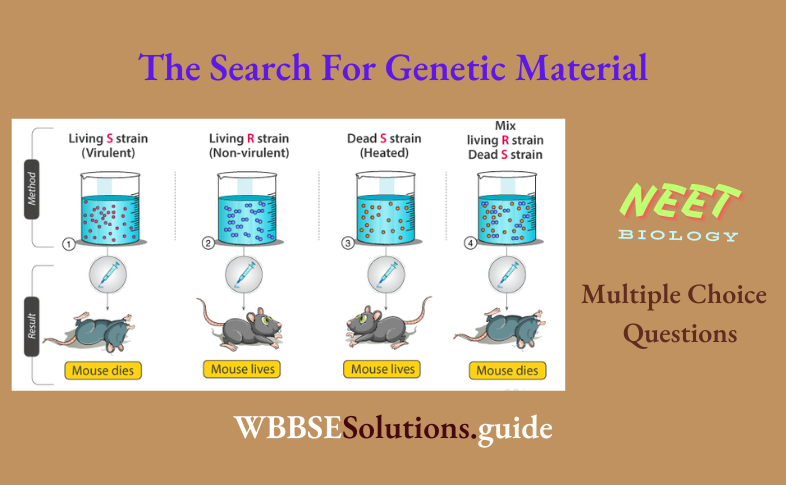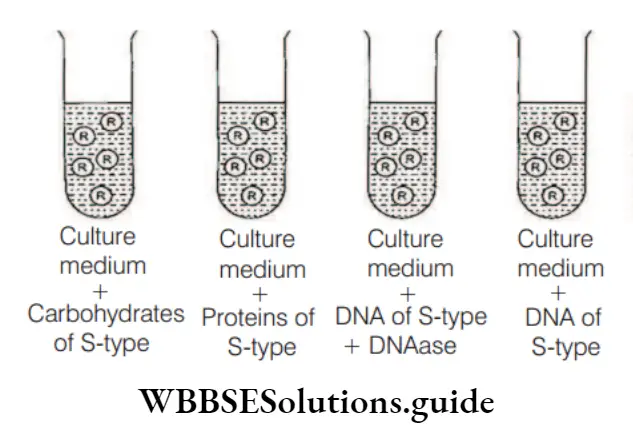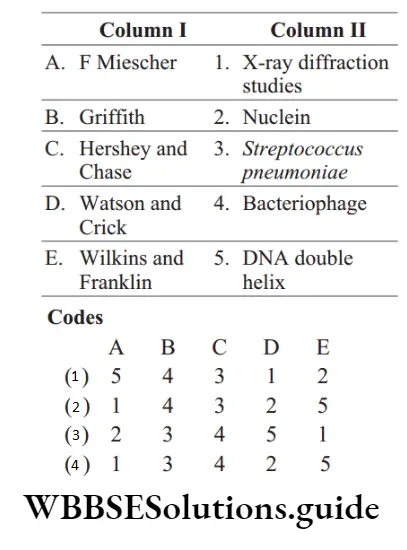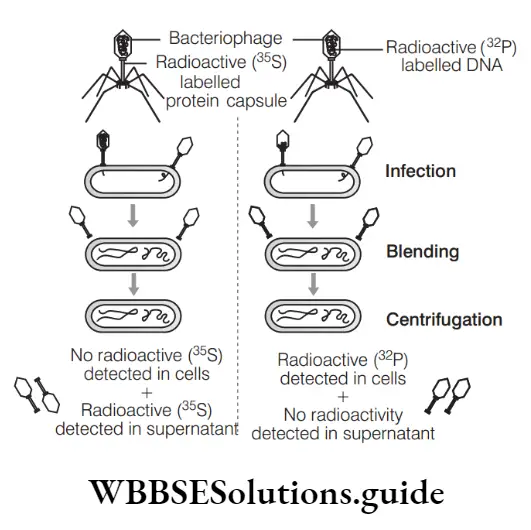Biology MCQ For NEET With Answers The Search For Genetic Material
Question 1. Who introduced the transforming principle?
- Frederick Griffith
- Oswald Avery
- Colin MacLeod
- Maclyn McCarty
Answer: 1. Frederick Griffith
The transforming principle (Griffith’s experiment) was introduced by Frederick Griffith (1920). He conducted a series of experiments with Streptococcus pneumoniae and found that a living organism (bacteria) had changed in physical form.
Question 2. The experimental organism used by Frederick and Griffith was
- Variola virus
- Streptococcus pseudopneumoniae
- Actinomycetes
- Streptococcus pneumoniae
Answer: 4. Streptococcus pneumoniae
The transforming principle (Griffith’s experiment) was introduced by Frederick Griffith (1920). He conducted a series of experiments with Streptococcus pneumoniae and found that a living organism (bacteria) had changed in physical form.
Read And Learn More: NEET Biology Multiple Choice Question And Answers
Question 3. Transfer of DNA from one bacterium to another by contact is known as
- Conjugation
- Transformation
- Transduction
- Transcription
Answer: 1. Conjugation
Conjugation is the process by which one bacterium transfers genetic material to another through direct contact. During conjugation, one bacterium serves as the donor of the genetic material and the other serves as the recipient.
The donor bacterium carries a DNA sequence called the fertility factor or F-factor.
Biology MCQ For NEET With Answers

Question 4. Consider the following statements.
- S. pneumoniae produce two types of colonies, viz. smooth and rough.
- S-type bacteria form smooth colonies due to the absence of a polysaccharide coat.
Choose the correct option.
- Statement 1 is correct, but 2 is incorrect
- Statement 1 is incorrect, but 2 is correct
- Both statements 1 and 2 are correct
- Both statements 1 and 2 are incorrect
Answer: 1. Statement 1 is correct, but 2 is incorrect
Statement I is correct, but II is incorrect. The incorrect statement can be corrected as S-type bacteria form a smooth colony because they possess polysaccharide (mucus) coat around themselves, whereas R-type bacteria do not form any covering around themselves
Question 5. S-type strain streptococcus pneumoniae is
- Capsulated, virulent, smooth
- Non-capsulated, avirulent, rough
- Capsulated, avirulent, rough
- Non-capsulated, virulent, smooth
Answer: 1. Capsulated, virulent, smooth
An S-type strain of S. pneumoniae is capsulated, virulent and smooth in appearance
Question 6. What was unique in Griffith’s experiments?
- DNA was found to be the genetic material
- RNA was found to be the genetic material
- Something from dead organisms could change the living cells
- The genetic makeup of dead and living organisms was the same
Answer: 3. Something from dead organisms could change the living cells
In Griffith’s experiment, Griffith found that something from a dead organism could change the living cells. From his experiment, he showed that dead S-bacteria changed or transformed the R-bacteria into S-type.
Biology MCQ For NEET With Answers
Question 7. What happened when heat-killed S cells along with live R cells were injected into mice?
- Mice survived and showed live S cells
- Mice died and showed live S cells
- Mice survived and showed live R cells
- Mice died and showed live R cells
Answer: 2. Mice died and showed live S cells
As a part of his experiments, Griffith tried injecting mice with heat-killed S bacteria. Unsurprisingly, the heat-killed S bacteria did not cause disease in mice.
However, when harmless R bacteria were combined with harmless heat-killed S bacteria and injected into a mouse, the mouse developed pneumonia and died. When Griffith took a blood sample from the dead mouse, he found that it contained living S bacteria.
Question 8. Choose the statements that are correct about Griffith’s experiment.
- S-strain has a capsule.
- The mouse will die if injected with living S-strain.
- The mouse will die if injected with living R-strain.
- The transforming principle is associated with a capsule of S-strain.
- Transformation of the R-strain into the S-strain can take place in a test tube.
Choose the correct answer
- 1 and 2
- 3 and 4
- 1, 2 and 5
- 3, 4 and 5
Answer: 3. 1 and 2
Statements 1, 2 and 5 are correct, while 3 and 4 are incorrect. These can be corrected as In Griffith’s experiment, mice did not die when living if injected with R-strain because R-strain is non-virulent.
The transforming principle is associated with the genetic material (transforming material) of S-bacteria.
Question 9. The transformation experiment of Griffith was proved by
- Griffith himself
- Avery, MacLeod, McCarty
- Meselson
- Beadle and Tatum
Answer: 2. Avery, MacLeod, McCarty

Oswald Avery, Colin MacLeod and Maclyn McCarty (1933-44) worked to determine the biochemical nature of ‘the transforming principle in Griffith’s experiment’.
They purified biochemicals like proteins, DNA, RNA, etc., from the heat-killed S-cell to observe which one could transform live R-cells into S-cells.
They discovered that DNA alone from S-bacteria caused the R-bacteria to transform.
Digestion with DNase inhibited transformation, suggesting that DNA is the heredity material
Biology MCQ For NEET With Answers
Question 10. The result of the following reaction experiments carried out by Avery et at., on Streptococcus pneumoniae, has proved conclusively that DNA is the genetic material.
- Live R-strain + DNA from S-strain + RNase
- Live R-strain + DNA from S-strain + DNase
- Live R-strain + Denatured DNA of S-strain + protease
- Heat killed R- strain + DNA from S-strain + DNase
Answer: 2. Live R-strain + DNA from S-strain + DNase
R-strain is rough and harmless, while S-strain is a smooth and virulent form of Streptococcus pneumoniae.
In their experiment, Avery et al. found out that only when DNA from S-type bacteria was added to a culture of R-type bacteria, R-type got converted to an S-type strain.
This transformation of R into S-type did not occur with the addition of carbohydrates or protein from S-type bacteria. Also, when the DNase enzyme was added, i.e. live R-strain + DNA (S-strain) + DNase, the transformation did not occur. It proved conclusively that DNA, indeed is the genetic material.
Question 11. What is the difference in the transformation experiment of Griffith and Avery, MacLeod and McCarty?
- Use of heat-killed R-type
- Use of deoxyribonuclease
- Use of proteins
- Use of S-type
Answer: 2. Use of deoxyribonuclease
The use of deoxyribonuclease (DNase) enabled Avery, MacLeod and McCarty to prove that DNA is the genetic material. This enzyme was not used by Griffith in his experiments
Question 12. The final proof for DNA as the genetic material came from the experiments of
- Griffith
- Hershey and Chase
- Avery, MacLeod and McCarty
- Hargobind Khorana
Answer: 2. Hershey and Chase
Hershey and Chase gave unequivocal proof that DNA is genetic material.
Question 13. Which experiment proved that DNA is the genetic material?
- Transformation Haryana PMT 2003
- Transduction
- Infection of tobacco with TMV
- Lederberg’s Replica experiment
Answer: 1. Transformation Haryana PMT 2003
The unequivocal proof that DNA is genetic material was given by a transformation experiment performed by Alfred Hershey and Martha Chase in 1952.
They worked with viruses that infect bacteria called bacteriophages. Hershey and Chase used 35 S and 32 P to prove that DNA is genetic material.
Question 14. Match the following columns.

Answer: 3. A–2, B–3, C–4, D–5, E–1
Question 15. Experiments which proved DNA to be hereditary material were conducted on Manipal 2008
- Drosophila
- Bacteria
- Mice
- Bacteriophages
Answer: 4. Bacteriophages
The unequivocal proof that DNA is genetic material was given by a transformation experiment performed by Alfred Hershey and Martha Chase in 1952.
They worked with viruses that infect bacteria called bacteriophages. Hershey and Chase used 35 S and 32 P to prove that DNA is genetic material.
Biology MCQs with answers for NEET
Question 16. In Hershey and Chase’s experiment, bacteriophage nucleic acids were labelled as
- 32P labelled phosphate
- 3H labelled H O2
- 35S labelled sulphate
- 14C labelled CO2
Answer: 1. 32P labelled phosphate
AD Hershey and Martha Chase (1952) grew cultures of Escherichia coli. One culture was treated with radioactive sulphur, 35 S which had a bacteriophage protein coat. The other culture was treated with radioactive phosphorus, 32 P.
Radioactive sulphur got incorporated into sulphur-containing amino acids(cysteine and methionine) and therefore, became part of bacterial protein.
Radioactive phosphorus got incorporated into nucleotides, which formed the nucleic acids, mostly DNA. So, bacteriophage nucleic acid was labelled as 32 P phosphates.
Question 17. The bacteriophage protein coat was labelled by ……… in the Hershey and Chase experiment.
- 35S labelled sulphur
- 32S labelled sulphate
- The 30S labelled sulphur
- 32P labelled sulphate
Answer: 1. 35S labelled sulphur
AD Hershey and Martha Chase (1952) grew cultures of Escherichia coli. One culture was treated with radioactive sulphur, 35 S which had a bacteriophage protein coat.
The other culture was treated with radioactive phosphorus, 32 P.
Radioactive sulphur got incorporated into sulphur-containing amino acids (cysteine and methionine) and therefore, became part of bacterial protein.
Radioactive phosphorus got incorporated into nucleotides, which formed the nucleic acids, mostly DNA. So, bacteriophage nucleic acid was labelled as 32 P phosphates.
Biology MCQs with answers for NEET
Question 18. In Hershey and Chase’s experiment, radioactive 32 P was used to culture bacteriophage which resulted in radioactive Kerala
- Viral DNA
- Bacterial capsule
- Viral protein
- The plasma membrane of bacteria
- Protein capsule of bacteriophage
Answer: 1. Viral DNA
Hershey and Chase grew some viruses on a medium that contained radioactive phosphorus 32 P and some others on a medium that contained radioactive sulphur ( 35 S).
Viruses grown in the presence of radioactive phosphorus contain radioactive DNA, but not radioactive protein because DNA contains phosphorus but the protein coat lacks it.
Similarly, viruses grown on radioactive sulphur contained radioactive protein coat but not radioactive DNA because DNA does not contain sulphur.
Question 19. Hershey and Chase used 35 S and 32 P to prove that DNA is the genetic material. Their experiments proved that DNA is genetic material because
- Progeny bacterial cell retained 32P, but not 35S
- Retention of 32P in progeny bacterial cells indicated that DNA was passed on
- Loss of 35S in progeny bacterial cells indicated that proteins were not passed on
- All of the above
Answer: 4. All of the above

Hershey and Chase used 35 S and 32 P to prove that DNA is genetic material because Progeny bacterial cells retained 32 P, but not 35 S. Retention of 32 P in progeny bacterial cells indicated that DNA was passed on.
Loss of 35 S in progeny bacterial cells indicated that proteins were not passed on and it remained in supernatant only.
Biology MCQs with answers for NEET
Question 20. Hershey was awarded the Nobel Prize in 1969 for providing
- X-ray crystallographic technique
- Helical coiling of DNA
- Proof of DNA as genetic material
- Semiconservative DNA replication
Answer: 3. Proof of DNA as genetic material
Hershey shared the 1969 Nobel Prize in Physiology or Medicine with Max Delbrück and Salvador Luria for their ‘discoveries to prove that DNA is genetic material.
Question 21. Consider the following statements about the Hershey and Chase experiment.
- Sulphur is present in proteins, but not in DNA.
- Phosphorus is present in DNA, but not in protein.
Choose the correct option.
- Statement 1 is correct, but 2 is incorrect
- Statement 1 is incorrect, but 2 is correct
- Both statements 1 and 2 are correct
- Both statements 1 and 2 are incorrect
Answer: 3. Both statements 1 and 2 are correct
Hershey and Chase grew some viruses on a medium that contained radioactive phosphorus 32 P and some others on a medium that contained radioactive sulphur ( 35 S).
Viruses grown in the presence of radioactive phosphorus contain radioactive DNA, but not radioactive protein because DNA contains phosphorus but the protein coat lacks it.
Similarly, viruses grown on radioactive sulphur contained radioactive protein coat but not radioactive DNA because DNA does not contain sulphur.
Question 22. In Hershey-Chase’s experiment, when the radioactive viruses were allowed to infect E. coli, what was observed?
- E. coli which was infected by viruses with radioactive DNA became radioactive.
- E. coli which was infected by viruses with radioactive protein did not become radioactive.
- E. coli which was infected by viruses with radioactive DNA did not become radioactive.
- E. coli which was infected by viruses with radioactive protein became radioactive.
Choose the correct option.
- 1 and 2 were observed
- 2 and 3 were observed
- 3 and 4 were observed
- 1 and 4 were observed
Answer: 1. 1 and 2 were observed
Hershey and Chase found that when bacteriophages containing 32 P or radioactive DNA, were allowed to infect non-radioactive bacteria, all the infected cells became radioactive and in fact, much of the radioactivity was passed on to the next generation of E. coli bacteria.
Question 23. DNA with labelled thymidine is added to a medium where Escherichia coli is growing. After 5 minutes of growth
- All the DNA strands of parents and daughters will show DNA with labelled thymidine
- Only parental strands will show thymidine-labelled DNA
- All the strands of daughters will be thymidine-labelled
- Half the daughter strands will have labelled and half strands without labelled thymidine
Answer: 3. All the strands of daughters will be thymidine-labelled
All the strands of the daughter cell would be thymidine labelled because DNA acts as genetic material.
Question 24. A molecule to acts as a genetic material has the following properties Kerala.
- Should be able to replicate it.
- Should be structurally more stable.
- Should be more reactive and labile.
- Should provide scope for slow changes.
Choose the correct option.
- 1, 2 and 3 are correct
- 3 alone is correct
- 3 and 4 are correct
- 1, 2 and 4 are correct
- 1 alone am correct
Answer: 4. 1, 2 and 4 are correct
For a molecule to act as a genetic material must fulfil the following criteria
It should be able to replicate or form its carbon copies. Genetic material should be able to express itself through the formation of specific biochemicals.
There are occasional changes or mutations in the structure and functioning of its genes which are of permanent nature and inheritable.
Mutations are essential for evolution and adaptability. It should be stable both chemically and physically. Thus, statement III is incorrect, while the other three are correct
Question 25. Identify the correct statement.
- DNA is dependent on RNA for the synthesis of proteins
- DNA and RNA both function as genetic material
- DNA is more stable and is the preferred genetic material but for the transmission of genetic information, RNA is better
- All of the above
Answer: 4. All of the above
All the given statements are correct.

